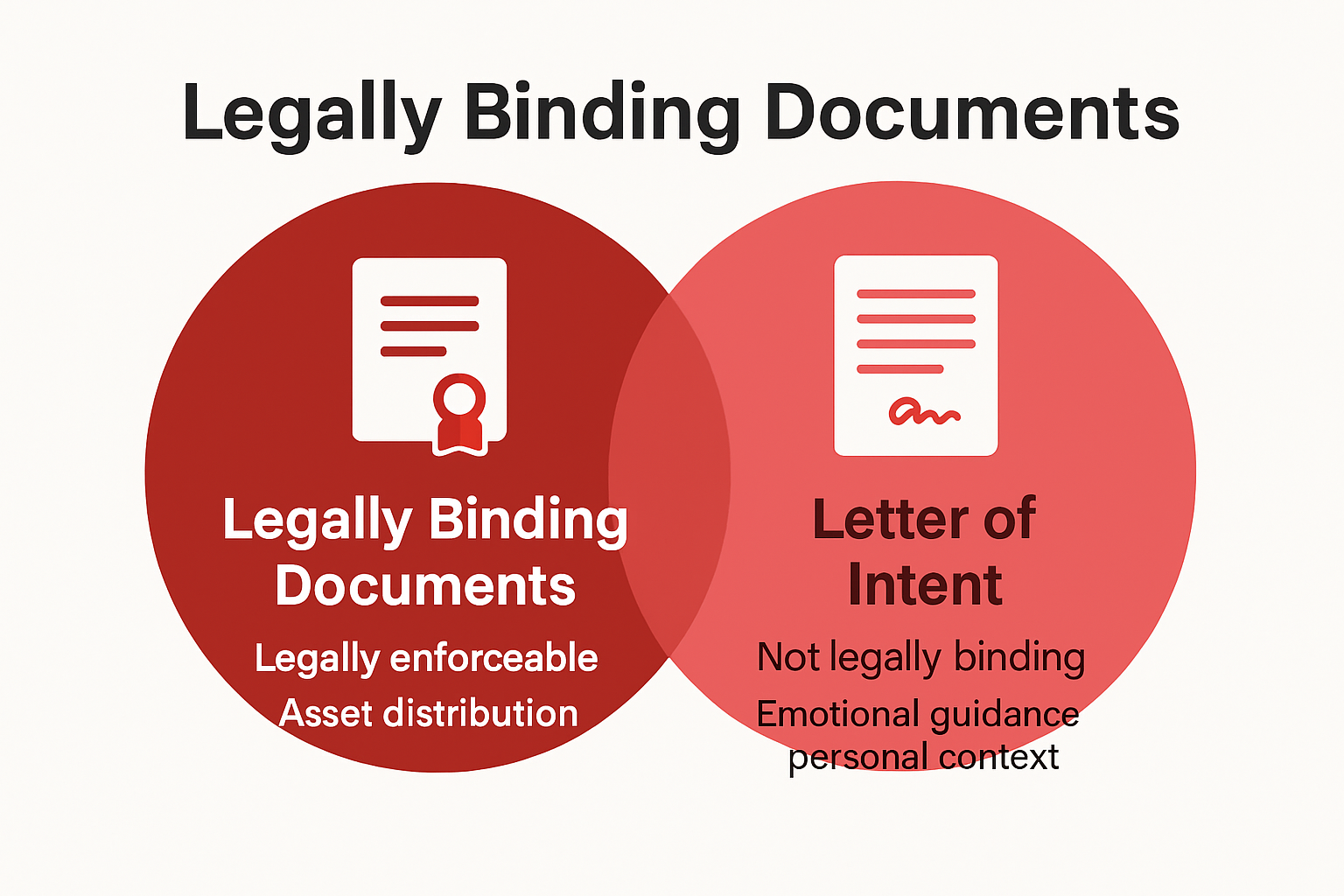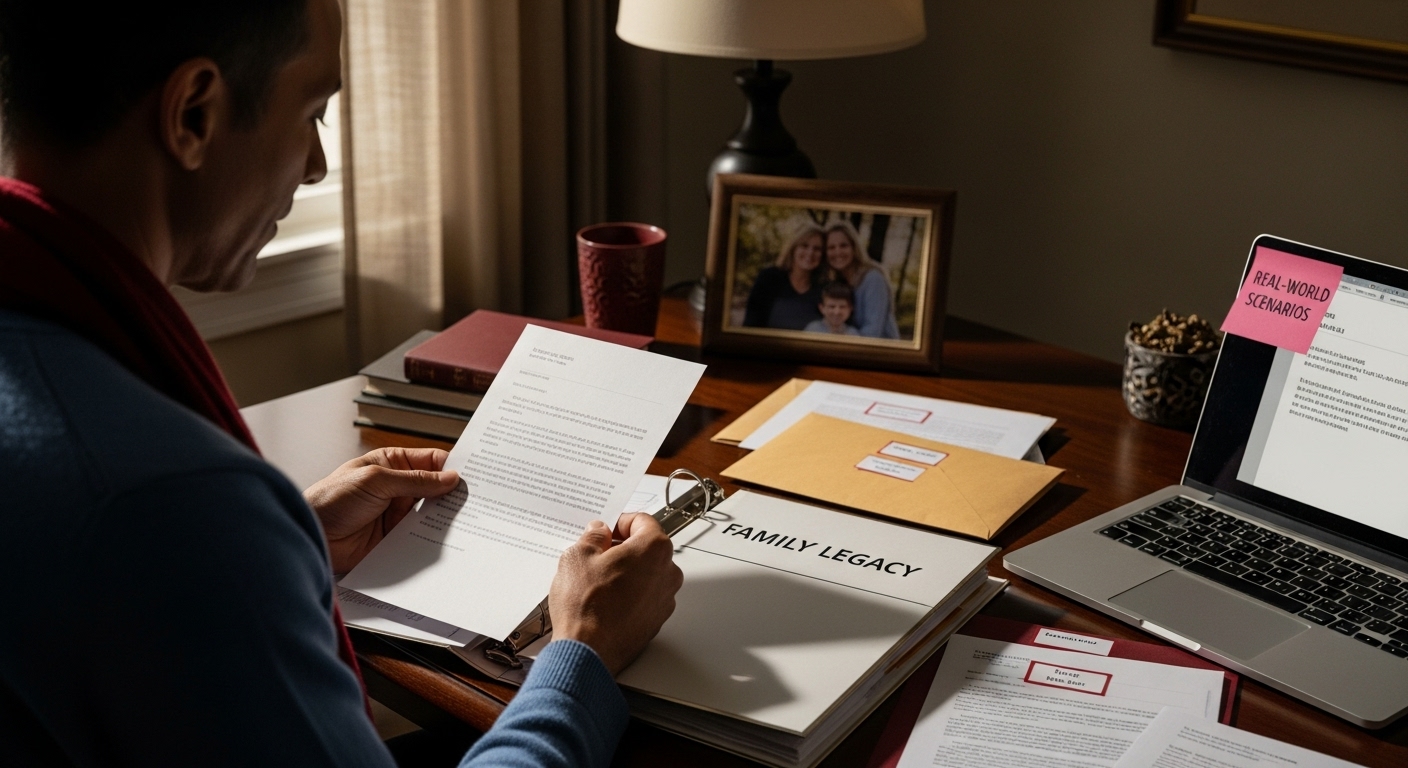
PARENTS & HOMEOWNERS: MY 7-STEP ESTATE PLANNING PROCESS WILL PROTECT YOUR HEIRS
From Creditors, Predators & Bad Choices, And Will Help You Become a (Bigger) Hero to Your Family!



Understanding Letter of Intent in Estate Planning
A letter of intent in estate planning does a lot more than many people expect. Most assume it is just an extra piece of paperwork, but the right letter can completely transform how your wishes are understood. Over 80 percent of executors say detailed letters of intent help prevent family conflicts and clarify decisions that a will alone cannot address. This simple document can make the difference between confusion and clarity for your loved ones.
Table of Contents
- What Is A Letter Of Intent In Estate Planning?
- Why Is A Letter Of Intent Important For Families?
- How Does A Letter Of Intent Work In Estate Planning?
- Key Components Of An Effective Letter Of Intent
- Real-World Scenarios: Utilizing Letters Of Intent
Quick Summary
| Takeaway | Explanation |
|---|---|
| A letter of intent supplements formal estate documents | It provides personalized guidance and emotional context beyond what wills and trusts offer. |
| Clarify asset distribution and family dynamics | Use the letter to explain the reasons behind inheritance choices, reducing misunderstandings among beneficiaries. |
| Not legally binding but influential | While it lacks legal weight, executors and family often regard it as moral guidance and adhere to its instructions closely. |
| Focus on emotional clarity and communication | A well-crafted letter helps families navigate complex emotions and enhances communication during transitions. |
| Include specific instructions about unique assets | Guidance on the management of special assets and personal heirlooms can significantly ease the distribution process for beneficiaries. |
What is a Letter of Intent in Estate Planning?
A letter of intent is a powerful yet flexible legal document in estate planning that provides detailed guidance and personal instructions beyond traditional legal documents. Unlike a will or trust, this informal document offers a comprehensive, personalized roadmap for managing your assets and expressing your wishes to family members and executors.
The Purpose and Significance
A letter of intent serves multiple critical functions in estate planning. It acts as a supplementary document that communicates your specific desires, personal context, and nuanced instructions that cannot be easily captured in formal legal documents. The role of an estate planning attorney becomes crucial in helping you craft a comprehensive letter of intent that truly reflects your unique family dynamics and personal wishes.
Key purposes of a letter of intent include:
- Providing emotional context and personal narrative around asset distribution
- Explaining the reasoning behind specific inheritance decisions
- Offering guidance on managing complex or unique assets
- Expressing personal wishes regarding care for dependents
- Clarifying potential ambiguities in your formal estate planning documents
Legal Status and Practical Application
While a letter of intent is not legally binding in the same manner as a will or trust, it carries significant moral and practical weight. Executors and beneficiaries typically view these documents as strong moral guidance, often following the instructions closely.
 The document can include everything from specific instructions about cherished family heirlooms to detailed guidance about the care of minor children or family members with special needs.
The document can include everything from specific instructions about cherished family heirlooms to detailed guidance about the care of minor children or family members with special needs.
The most effective letters of intent are clear, compassionate, and comprehensive. They bridge the gap between cold legal language and warm human understanding, ensuring that your final wishes are communicated with clarity and personal touch. By providing context, explanations, and heartfelt guidance, you help your loved ones navigate the complex emotional and practical landscape of estate distribution with greater ease and understanding.
The following table compares the legal and practical aspects of a letter of intent versus wills and trusts in estate planning to clarify their roles and significance for readers.
| Document Type | Legally Binding? | Purpose | Typical Content | Role for Executors |
|---|---|---|---|---|
| Will or Trust | Yes | Formally directs asset distribution and guardianship | Legal asset transfer, guardianship appointments | Primary legal guidance |
| Letter of Intent | No | Provides emotional context and personal instructions | Explanations, guidance, personal messages, unique asset management | Supplemental moral/practical guidance |
Why is a Letter of Intent Important for Families?
A letter of intent serves as a critical emotional and practical bridge between legal documents and family understanding, offering a unique mechanism for preserving family harmony and providing clear guidance during challenging transitions. Family meetings about estate planning can be significantly enhanced by including a comprehensive letter of intent that communicates nuanced personal wishes.
Emotional Clarity and Family Communication
Families often struggle with complex emotions surrounding inheritance and asset distribution. A letter of intent provides a compassionate platform for explaining personal decisions, reducing potential misunderstandings and conflicts. By articulating the reasoning behind specific inheritance choices, parents can help prevent resentment and confusion among beneficiaries.
Key emotional benefits include:
- Demonstrating thoughtful consideration behind asset allocation
- Expressing love and care through detailed personal instructions
- Providing context for potentially challenging inheritance decisions
- Offering emotional closure and understanding for family members
- Reducing potential interpersonal tensions during grief
Practical Guidance Beyond Legal Frameworks
Beyond emotional support, a letter of intent offers practical guidance that standard legal documents cannot capture. It can include specific instructions about family heirlooms, personal values, educational expectations for children, and nuanced care instructions for dependents. This document becomes a personal roadmap that helps executors and beneficiaries understand the deeper intentions behind estate planning decisions.
Moreover, a well-crafted letter of intent can address complex family dynamics, explain unique asset management strategies, and provide insights into family history and personal values. It transforms estate planning from a purely legal transaction into a meaningful, personalized communication that honors both the financial and emotional aspects of legacy planning.
How Does a Letter of Intent Work in Estate Planning?
A letter of intent operates as a strategic communication tool within the estate planning process, functioning as a detailed, personalized guide that complements formal legal documents. How to talk to your parents about estate planning can often be simplified by understanding the mechanics of how a letter of intent works and its practical implementation.
Composition and Content Structure
The effectiveness of a letter of intent lies in its comprehensive yet flexible approach to documenting personal wishes.
Unlike rigid legal documents, this letter allows for a more narrative and contextual explanation of your estate planning decisions. Individuals can provide detailed insights into asset distribution, personal values, and specific instructions that might not fit within traditional legal frameworks.
Key elements typically included in a letter of intent are:
- Specific instructions for managing unique or complex assets
- Personal narrative explaining inheritance decisions
- Guidance for guardianship of minor children
- Explanations of family dynamics and potential conflict resolution
- Emotional context and personal messages for beneficiaries
Practical Implementation and Executor Guidance
While not legally binding, a letter of intent serves as a powerful moral and practical guide for executors and beneficiaries. Executors often use this document as a comprehensive reference point when navigating complex estate distribution scenarios. The letter helps bridge potential communication gaps, providing clarity and context that formal legal documents cannot capture.
The most effective letters of intent are meticulously crafted, combining emotional intelligence with practical guidance. They offer a unique opportunity to communicate personal values, explain nuanced decisions, and provide a holistic view of your estate planning intentions. By creating a detailed, compassionate document, you help ensure that your final wishes are understood and respected, minimizing potential misunderstandings or conflicts among family members during an already challenging time.
Key Components of an Effective Letter of Intent
Crafting a comprehensive letter of intent requires careful consideration and strategic planning. The document must strike a delicate balance between practical instructions and personal emotional context, providing clear guidance while maintaining a compassionate tone. How to plan your estate for charitable giving can be effectively integrated into this process by understanding the essential components that make a letter of intent truly meaningful.
Personal and Financial Context
An effective letter of intent begins with establishing a robust personal and financial context. This section goes beyond mere financial details, offering a holistic narrative that explains the underlying philosophy of your estate planning decisions. By providing comprehensive background information, you help executors and beneficiaries understand the reasoning behind your choices, reducing potential misunderstandings and conflicts.
Critical elements to include in this context are:
- Detailed family history and relationship dynamics
- Overview of significant life events influencing estate decisions
- Explanation of personal values and financial principles
- Background on asset origins and sentimental significance
- Insights into long term family goals and expectations
Specific Asset and Inheritance Instructions
The core of a letter of intent lies in its detailed, nuanced instructions regarding asset distribution and inheritance. Unlike formal legal documents, this section allows for a more flexible and descriptive approach to explaining your wishes. You can provide specific guidance about unique assets, personal preferences for distribution, and conditional instructions that might be challenging to capture in traditional legal language.
A well-crafted letter of intent transforms estate planning from a clinical legal process into a deeply personal communication. It serves as a bridge between cold legal documentation and warm human understanding, ensuring that your final wishes are not just legally executed but emotionally comprehended.
This table outlines the key components of an effective letter of intent, summarizing what each section should address for maximum clarity and usefulness.
| Component | Description |
|---|---|
| Personal and Financial Context | Explains family history, major life events, personal values, and financial philosophy |
| Specific Asset Instructions | Details on distribution or management of unique and sentimental assets |
| Inheritance Explanations | Clarifies reasoning for specific bequests or decisions |
| Guardian and Dependent Guidance | Provides instructions for care of children or special needs dependents |
| Family Dynamics and Conflict | Addresses potential conflicts, explains expectations, offers solutions |
| Emotional Messages | Personalized statements to comfort, support, and guide beneficiaries |
| By carefully articulating your intentions, you provide your loved ones with a compassionate roadmap that honors both your financial legacy and your personal values. |
Real-World Scenarios: Utilizing Letters of Intent
Letters of intent transform abstract estate planning concepts into tangible, practical guidance that can navigate complex family dynamics and unique asset situations. Estate planning for young families particularly benefits from these personalized documents, which provide clarity and emotional context during challenging transitions.
Complex Family Dynamics
Real-world scenarios often involve intricate family relationships that standard legal documents cannot adequately address. A letter of intent becomes a crucial tool for communicating nuanced expectations and providing emotional context. For instance, in blended families with children from previous marriages, a detailed letter can explain inheritance decisions, clarify potential points of tension, and ensure that all family members feel respected and understood.
Scenarios where letters of intent prove particularly valuable include:
- Explaining unequal inheritance distributions
- Providing context for guardianship choices
- Addressing potential family conflicts proactively
- Clarifying expectations for family businesses
- Detailing care instructions for special needs dependents
Unique Asset Management
Beyond family dynamics, letters of intent offer critical guidance for managing unique or complex assets that require specialized handling. This might include family businesses, intellectual property, valuable collections, or assets with significant sentimental value. A well-crafted letter can provide explicit instructions about preservation, management, and potential future disposition of these special assets.

The power of a letter of intent lies in its ability to humanize estate planning. It transforms a potentially clinical process into a deeply personal communication, ensuring that your final wishes are not just legally executed but emotionally understood. By providing context, explaining decisions, and sharing personal insights, you create a compassionate roadmap that guides your loved ones through a potentially challenging time of transition and loss.
Secure Your Wishes With a Personalized Letter of Intent
Are you concerned that your unique family dynamics or heartfelt wishes may not be fully captured by standard estate documents? Many people feel anxious about leaving behind uncertainty, confusion, or family conflict if their intentions are not clearly understood. As described in this article, a letter of intent bridges the gap between complex legal language and your personal values, offering detailed, compassionate guidance that goes beyond what a will or trust alone can provide. You deserve peace of mind knowing your story and your legacy will be honored as you intended. For more details about this essential aspect of your estate plan, explore our Estate Planning resources.

Let our team at The Law Offices of Eric Ridley guide you in crafting a letter of intent and comprehensive estate strategy tailored just for you. Take the first step today to prevent misunderstandings and protect your family’s future. Visit our site or book a consultation now to ensure your wishes are clearly documented and respected.
Frequently Asked Questions
What is a letter of intent in estate planning?
A letter of intent is a non-legally binding document that provides personalized guidance and instructions for asset distribution and family care beyond what is covered in formal legal documents like wills and trusts.
Why is a letter of intent important for families?
A letter of intent enhances emotional clarity and communication among family members, helping to reduce conflicts and misunderstandings during the estate distribution process by providing context and explanations for inheritance decisions.
How should I structure a letter of intent?
A well-structured letter of intent should include a personal and financial context, specific asset and inheritance instructions, and address family dynamics. It should articulate your values and provide clear guidance for your loved ones.
Can a letter of intent address complex family dynamics?
Yes, a letter of intent can effectively address complex family relationships by explaining inheritance decisions and clarifying expectations, especially in cases such as blended families or when there are unique asset management needs.
Recommended
- The Role of an Estate Planning Attorney in Your Future – Law Office of Eric Ridley
- “Understanding Estate Planning – Why Everyone Needs A Will And Trust” – Law Office of Eric Ridley
- How To Talk To Your Parents About Estate Planning – Law Office of Eric Ridley
- Common Mistakes to Avoid in Estate Planning – Law Office of Eric Ridley
